Mate, you should really check what has been posted and discussed beforehandUS FINALLY APPROVES SALE OF F-16 BLOCK 70S TO TURKEY
- US finally approves sale of F-16 Block 70s to Turkey
By Jon Lake 16th February 2024
NEWS
After a two-year delay, Turkey has finally gained approval from the US government to acquire 40 new-build F-16C/D Block 70 Fighting Falcon multi-role fighters and 79 F-16V upgrade kits in a deal worth approximately $23bn.
Ankara has had a long-standing requirement to recapitalise and upgrade its F-16C/D fleet but was initially blocked from acquiring the new Block 70 aircraft (and upgrading its existing ‘Vipers’ to the similar F-16V standard) primarily because of Turkey’s opposition to Sweden’s accession into the NATO alliance. Some US lawmakers also cited human rights concerns, while others (playing to a powerful Greek lobby) expressed concern over Turkish-Greek tensions in the Aegean region.
On January 26, the US formally approved the sale of 40 new-build F-16C/D Block 70s to Turkey, as well as 79 upgrade kits to enable the Turkish Air Force's existing F-16C/D fleet to F-16V standard. Ben Stanley Hall
Turkish President Recep Tayyip Erdoğan had objected to Sweden joining NATO because of its perceived acceptance of Kurdish groups, which Ankara views as terrorist organisations. Sweden took a number of security steps to mollify Turkey and even tightened its anti-terrorism legislation.
The Turkish parliament ratified Sweden’s NATO accession by 287 votes to 55 on January 23, prompting US President Joe Biden to ask lawmakers to green light the F-16C/D Block 70 (and F-16V) sale, and to note his administration’s welcome of “the Turkish parliament’s ratification of Sweden’s NATO accession protocols and informing them his administration intends to formally notify Congress of the sale of F-16s to Turkey as soon as this process is complete.”
The Biden administration notified the US Congress of its approval to sell 40 F-16C/D Block 70s and related equipment to Turkey on January 26, once Ankara’s instruments of ratification of Sweden’s NATO membership had arrived in Washington DC. Turkey turned its attention to the F-16C/D Block 70 after the US expelled Ankara from the F-35 programme in 2019, citing concerns that Turkey’s purchase of the Russian-made S-400 (SA-21 Growler) surface-to-air missile (SAM) system posed an unacceptable security risk. Following the approval of Turkey’s F-16 Block 70 deal, Washington immediately notified Congress of its intention to sell 40 F-35A fighters to Greece.
AFM
Latest Thread
You are using an out of date browser. It may not display this or other websites correctly.
You should upgrade or use an alternative browser.
You should upgrade or use an alternative browser.
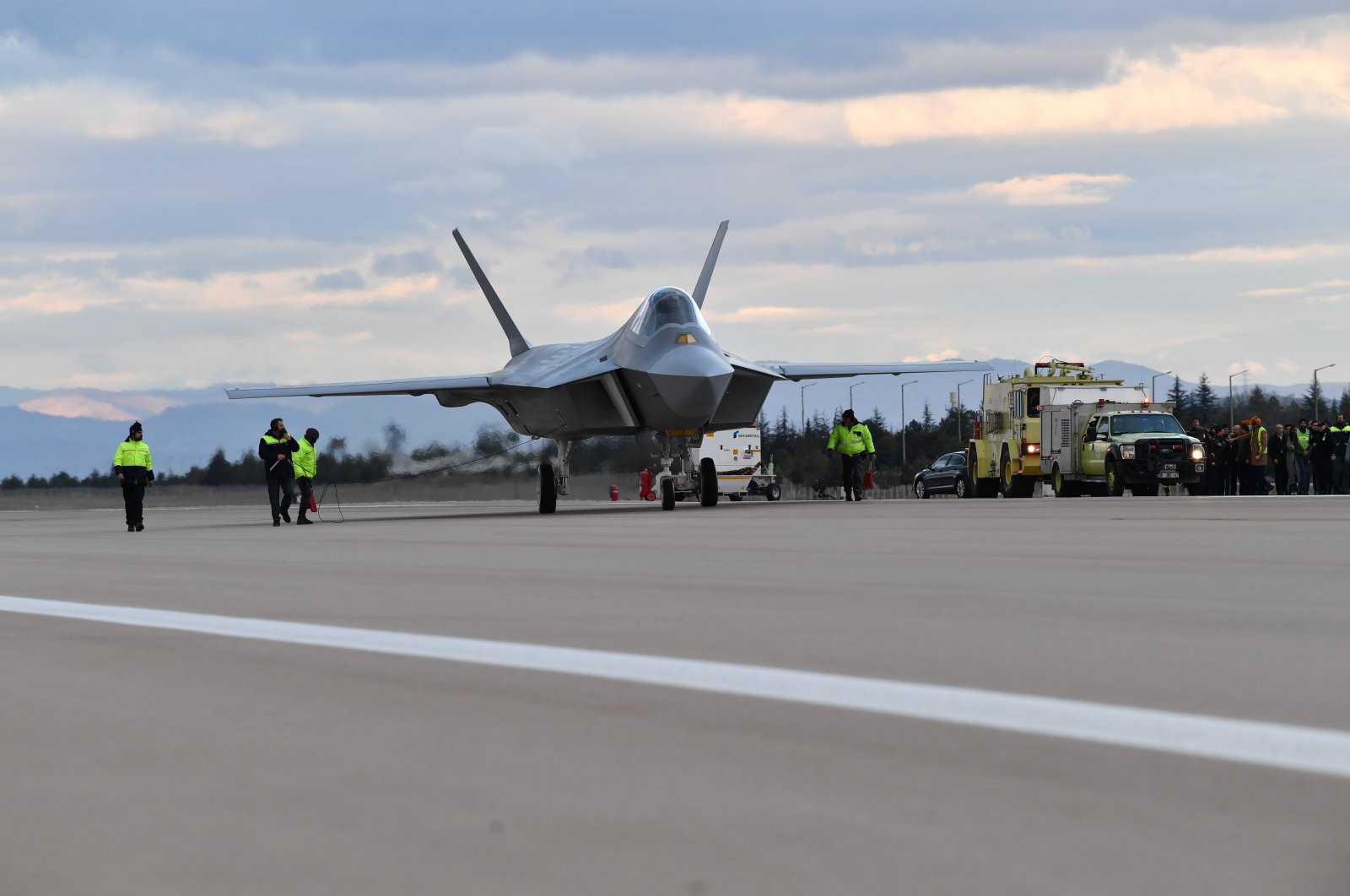
Turkish engine maker says fighter jet power unit almost ready
Türkiye's top engine manufacturer on Tuesday said a unit that will power the nation's first domestically developed fighter jet is almost ready,...
TURKISH TOUGH GUYS
- Aviation Features
- TURKISH TOUGH GUYS
By Giovanni Colla and Rich Cooper 1st August 2019
FEATURE
Three years after the drama of an attempted military coup, the Turkish Air Force’s ‘Anatolian Eagle’ exercise at Konya air base was held for two weeks in June with the host nation welcoming participants from Italy, Jordan, Pakistan, Qatar and the US.
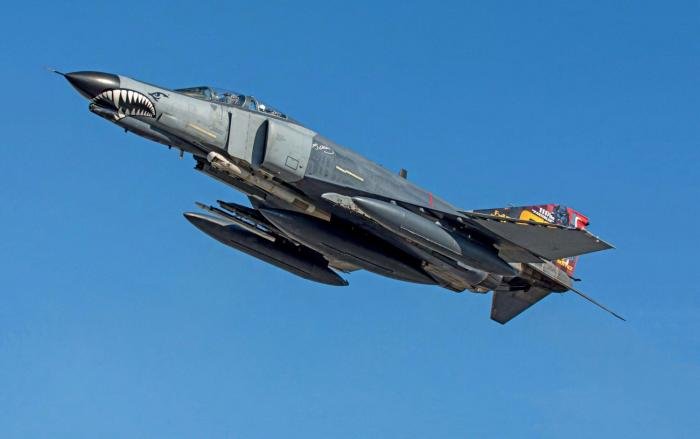
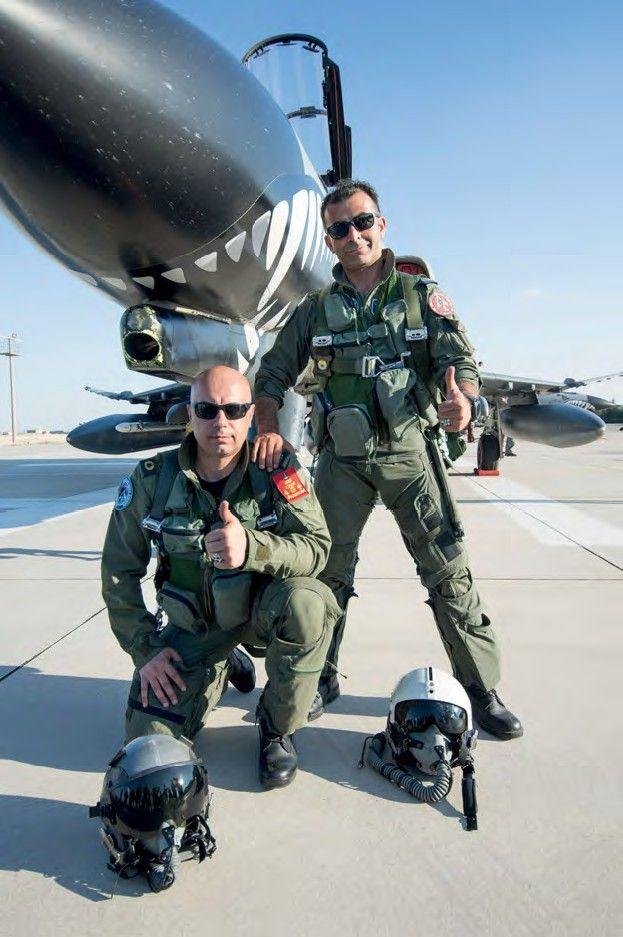
TURKEY IN JUNE, in full flying kit, is not for the fainthearted. Amid sweltering conditions, the Turkish Air Force (Türk Hava Kuvvetleri, THK) held its always hotly anticipated ‘Anatolian Eagle’ once again this summer. While exercises are commonplace and it’s all about teamwork — or interoperability, as the current buzzword goes — events such as this offer infrequent opportunities to get up close to some rare metal. Turkey is an important strategic country given its position as a link between Europe and the Middle East, and it has dramatically increased its training facilities over the last decades while gradually modernizing its armed forces to protect itselffrom the numerous pockets of instability in and around its borders. Leaving aside recent global publicity of US and Russian concerns about Turkey’s purchase of S-400 missiles alongside development of its F-35 program — Konya is one of the of the few THK bases that allows media access, located about 150 miles (240km) south of Ankara on the Anatolian plateau. The resident exercise dates back to June 2001 and to date some 14 countries have joined the THK for ‘Anatolian Eagle’ including Belgium, France, Germany, Israel, Italy, Jordan, the Netherlands, Pakistan, Qatar, Saudi Arabia, Spain, the United Arab Emirates, the UK and the US.
‘Anatolian Eagle’ operates in a similar way to the famous US ‘Red Flag’ exercise, and essentially features ‘Blue Force’ good guys against bandit ‘Red Air’ opponents. The latter were Turkish F-16s dedicated to the role while ‘real world’ scenarios were played out on a daily basis. For the 2019 edition, the scenario was a ‘Red’ country trying to take control of an oil port inside the friendly nation, thus opening up a wide variety of air combat tactics in a simulated conflict scenario. Maj Turgay Tümer told reporters that ‘Anatolian Eagle’ is ‘considered a laboratory in which needs are determined and solutions are developed along with continuously updated scenarios and missions played out with modern technology’.
Typical missions consisted of an attack by the ‘Blue’ team in a combined air operation (COMAO) against tactical and strategic targets within the area controlled by the ‘Red’ team, which was defended by fighters and a ground-based air defense (GBAD) systems.
A Command and Control Center (CCC) acted as the nerve center for the missions, collating information from range data pods carried by the fighters and also ground and airborne radar systems to enable a real-time picture of the operation. This is where it was decided which targets were successfully prosecuted and where air-to-air missile ‘shots’ were validated.
The main operating airspace went from ground level up to 50,000ft with zero fiight restrictions — but importantly it was located almost adjacent to Konya, thus minimizing transit time and maximizing ‘play’ time.
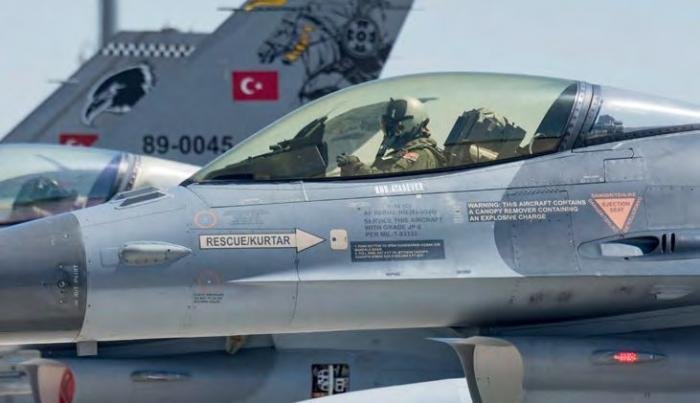
A very rare glimpse of one of the THK’s four C-160D ELINT/COMINT platforms as it gets airborne at Konya. Rich Cooper
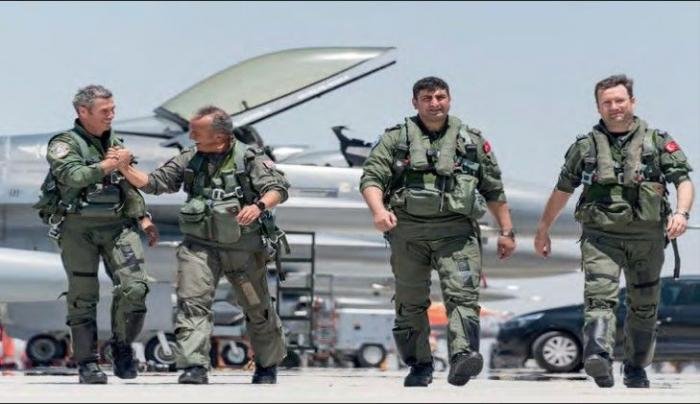
’Viper’ pilots chat enthusiastically as they walk back to ‘Anatolian Eagle’ headquarters. Rich Coope
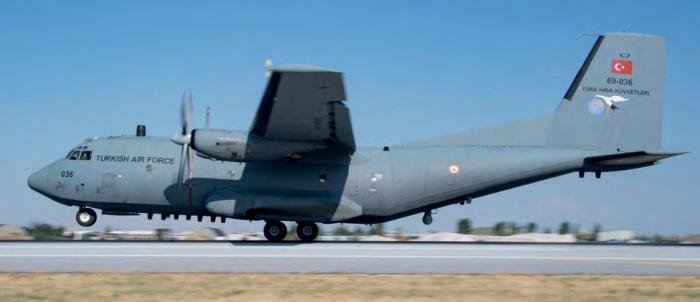
Jets mass at the end of runway (EOR) as the morning combined air operation (COMAO) gets under way. Rich Cooper
The players
This year’s ‘Anatolian Eagle’ involved participation from Italy, Jordan, NATO, Pakistan, Qatar, Turkey and the US, making a total number of more than 450 foreign and around 600 Turkish personnel. The home team consisted of 34 aircraft, including six F-4E-2020s assigned to 111 Filo ‘Panterler’ from Eskisehir; F-16C/D Block 30s and 52+ from 113, 132 (‘Red Air’), 152 and 161 Filos, plus E-7T airborne early warning and control aircraft, C-130B/Es, CN235s, KC-135R tankers plus, significantly, one of four THK C-160D Transalls from 221 Filo at Keyseri that are equipped for signals and communication intelligence (SIGINT/ COMINT) as well as imaging and radio frequency jamming.

With the cavernous E-7T hangars in the background, an F-16D launches as an F-4E-2020 makes its way to the runway. Rich Cooper
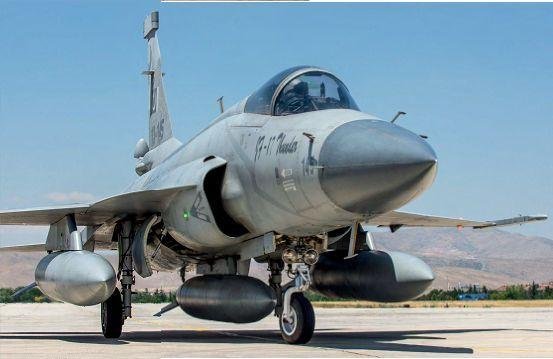
Pakistani JF-17 Thunders provided the exotic element of this year’s event, coming form the new No 28 ‘Phoenix’ Squadron. Giovanni Colla
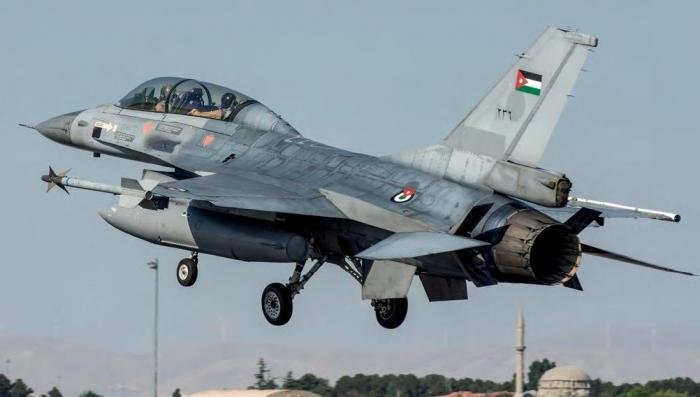
A Royal Jordanian Air Force (RJAF) F-16BM flares for landing with speed brakes open. Giovanni Colla
Foreign participants included three F-16AM/BMs from the Royal Jordanian Air Force, five JF-17 Thunders from the Pakistan Air Force’s No 28 ‘Phoenix’ Squadron, three AMX from the Italian Air Force’s 51° Stormo, six US Air Force F-15E Strike Eagles from RAF Lakenheath’s 494th Fighter Squadron (FS) ‘Panthers’, a single C-130J and C-17A Globemaster III from the Qatar Emiri Air Force and one NATO E-3 AWACS.
Unlike previous ‘Anatolian Eagles’, where the typical day included two missions — ‘Eagle 01’ and ‘Eagle 02’ — this year only saw a morning COMAO, with afternoons dedicated to training customized according to particular needs. Maj Tümer said: ‘For example, the Italian Air Force asked to fly and train with Turkish F-4E Phantoms at our nearby range for electronic warfare missions and to attack GBAD systems and to fly air-to-air missions against Turkish F-16s on the last day of exercise, while the USAFE requested its afternoon training to concentrate on lowlevel flying alongside the Turkish Air Force.’

The unmistakeable lines of the F-4E- 2020. Just one squadron in the THK still operates these magnificent beasts, although this example retains the markings of 171 Filo ‘Korsan’. Rich Cooper
It’s a wrap
In total, 389 sorties were flown during the two weeks and the signs were that ‘Anatolian Eagle’ remains a meaningful test of the aircrews, with some relative newcomers in the shape of the JF-17s able to take a lot away from the experience. The geographic positioning of Turkey means that participating air arms with very different procedures and methodologies are able to come together and reap the benefits. ‘I love meeting all of our international partners,’ said Maj Allison Mandas, a Weapons Systems Officer with the F-15Es of the 494th FS. ‘Exercises such as this provide an opportunity to share lessons learned, tactics and techniques so that we all have a shared operating picture for when conflict arises.’
Another ‘Panther’, 1st Lt Mike Nunez, added: ‘It’s been exciting to see the way they’ve looked at a tactical problem and then solved it — in just as valid a way as we would do it in the USAF, but perhaps employing a different method. It makes me confident that we can address any crisis that arises based on how well we come together at exercises like this.’
GROUNDBASED AIR DEFENSE
During the two weeks of exercise, the scenarios were deliberately varied and changeable. The threats, in addition to the air component provided by eight F-16C/Ds of the local 132 Filo, included some fairly ancient systems such as SA-6 ‘Gainful’, SA-8 ‘Gecko’ and SA-11 ‘Gadfly’, plus some more modern systems such as the SA-10 ‘Grumble’ and SA-15 ‘Gauntlet’.

Originally published in Combat Aircraft Journal
The plane is ...!?
The plane is ...!?
KC135. We can use them as transports as well.

To complete the image, here's another row...
Edit: Didn't merge it with the original image out of respect for the creator.
Happy Sunday folks. The weather is good, the sky is clear.
Last edited:
You have no idea what such 19 second montages do to the heart of an aviation buff who had the longing for a Turkish flying platform since their childhood.Happy Sunday folks. The weather is good, the sky is clear.
And blood touched the wolf's tooth.
ANKA's first flight was hard to top emotionally, except when KAAN was shown, that was in turn topped by its maiden flight. Indescribable!
Skip to main content
By and photos: Onur Kurc and Tayfun Yasar 2nd March 2017
FEATURE
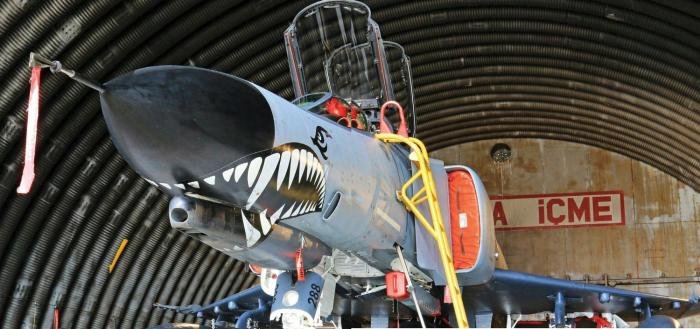
In its lair at Eskisehir is shark-mouthed 111 Filo ‘Panterler’ F-4E-2020 serial 77-0288, with an Elta EL/L-8222 jamming pod on the shoulder station.
Having undergone a major reshuffle in recent years, the Turkish Air Force has dramatically rationalized its F-4 Phantom II fleet as these warriors ultimately face retirement.
ESKISEHIR IS A city synonymous with the very essence of Turkish aviation. Located in the northwestern part of the country, the airfield has a strong link with the godfather of aeronautics in Turkey: Mustafa Kemal Atatürk. Eskisehir Air Base has housed every fast jet type operated by the Türk Hava Kuvvetleri (Turkish Air Force — THK) and still serves as the home of the 1st Air Base Command, the 1st Air Supply Maintenance Center and, most importantly, the Combat Air Force and Air Missile Defense Command — the glue that cements together all the THK combat elements.
With such a solid legacy, it comes as little surprise that Eskisehir was heavily involved with the arrival of the F-4E Phantom II in Turkish service from 1974. It is dificult to believe that the legendary Phantom II has served for nearly 43 years, and will likely continue in use until around 2020.
Phantom arrival
Turkey has always placed a huge emphasis on its armed forces due to its geographical and geopolitical location. With the country’s entry into NATO in 1952, a new aircraft with more firepower and higher performance was needed to replace the existing F-100C/D/Fs in the THK inventory. The F-4 Phantom II gained public attention during the Vietnam War and was a perfect match for Turkey’s demands at the time.
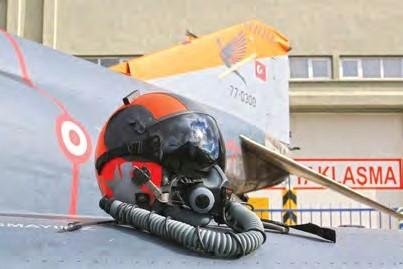
Therefore, 40 F-4Es were ordered under the ‘Peace Diamond I’ deal with the US. The era of the F-4 also heralded a step-change in air-to-ground capability with the likes of AGM-65A/B Maverick missiles, Pave Spike laser targeting pods, GBU-10/12 Paveway laser-guided bombs, electronic warfare pods and AIM-7 Sparrow medium-range air-to-air missiles. The Phantom was a major leap forward for the THK.
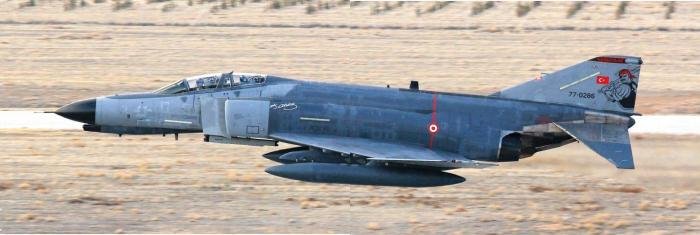
An F-4E flying low over the runway at Erhaç — ‘Korsanlar’ was disbanded during 2016 in the immediate aftermath of the coup attempt, although its demise was probably not linked.
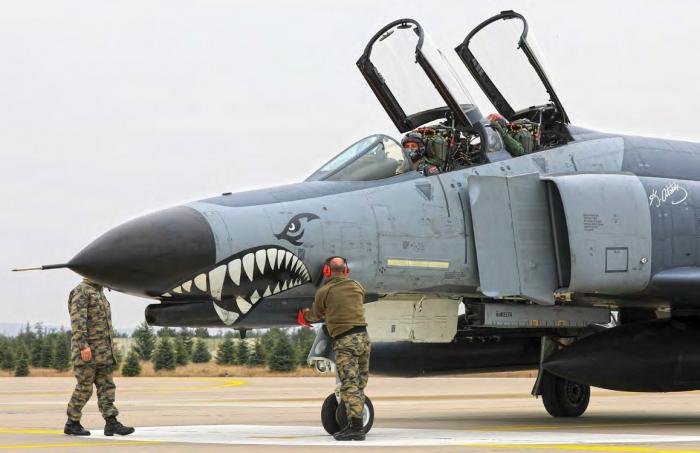
The last-chance check crew gives an Elta EL/L-8222 jamming pod-toting F-4E-2020 a final look over pre-flight.

Phantom tails — 171 Filo ‘Korsanlar’ markings remain in dwindling numbers now the unit has gone. The jet in the middle wears the standard 111 Filo ‘Panterler’ tail markings.
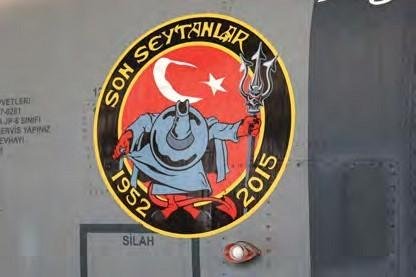
112 Filo ‘Şeytanlar’ stood down in June 2015.

The 5,000th F-4 built, serial 77-0290, still serves with 111 Filo.
The first two aircraft (serials 73-1016 and 73-1017) were flown into Eskişehir by US Air Force pilots on August 30, 1974, and delivered to 113 Filo. Tensions in Cyprus at that time resulted in the biggest combat air operation in the history of Turkish military aviation, the knock-on effect being a significant delay in the operational evolution of the F-4 in Turkey. Deliveries continued in 1975, by which time 22 aircraft equipped 112 Filo ‘Şeytanlar’ (Devils). The remaining 18, which were received after an arms embargo ended during 1977, entered service with 171 Filo ‘Korsanlar’ (Pirates) at Erhaç.
In 1978, the THK ordered a second batch of 40 aircraft, consisting of 32 F-4Es and eight RF-4Es bought under the ‘Peace Diamond II’ agreement. These joined 111 Filo ‘Panterler’ (Panthers) at Eskişehir and 172 Filo ‘Şahin’ (Hawk) at Erhaç. The charismatic RF-84Fs made way for the new RF-4Es, which equipped 113 Filo ‘Işık’ (Light) in 1980.
The story didn’t end there. Turkey was a huge fan of the F-4 and it was proving popular in service. Expansion of the fleet continued, and a further 14 F-4Es were acquired under ‘Peace Diamond III’, these joining 173 Filo ‘Şafak’ (Dawn) also at Erhaç. ‘Peace Diamond IV’ followed; it involved 15 more jets, mainly as attrition replacements, with ‘Peace Diamond V’ adding 40 surplus USAF F-4Es from October 1987. These finally saw off the remaining Super Sabres at Konya, with these Phantoms joining 131 Filo ‘Dragon’ and 132 Filo ‘Hançer’ (Dagger) here. The final batch of deliveries came shortly after the Gulf War ended in 1991, another 40 F-4Es arriving from the US under ‘Peace Diamond VI’.
The end of the Cold War and the military draw-down in northern Europe presented a new opportunity for Turkey. Surplus Luftwaffe RF-4Es were snapped up both by the THK and its neighbor Greece — 46 of these jets (including 13 held in reserve as spares sources) were delivered between 1992 and 1994. Under Project ‘Kaan’, Turkey upgraded these aircraft immediately, replacing the original AN/ APQ-99 radar systems with the newer AN/APQ-172.
These jets boosted 113 Filo at Eskişehir and enabled standardization on a fleet of 20 aircraft per squadron. The remaining examples joined 173 Filo at Erhaç, thus forming a new reconnaissance unit and pushing out the F-4Es to establish 172 Filo alongside them at Erhaç. These ex-Luftwaffe jets initially retained their three-tone ‘Norm 83’ black and green camouflage, but later received a South- East Asia green and brown scheme.
F-4E-2020 AT A GLANCE
In addition to structural work, the 54 F-4E-2020 aircraft were equipped with the Elta EL/M-2032 multi-mode fire control radar with a 144km-range, ELOP 976 wideangle head-up display (HUD), hands-on throttle and stick (HOTAS) controls, new UHF/VHF radio antennas, improved INS/ GPS navigation, new multi-function cockpit displays, flight data recorders, a new radar warning receiver (RWR) and electronic warfare upgrades. Airframe life was extended to 6,000 flight hours.
Another capability for the 2020 was the addition of the AGM-142 Popeye longrange air-to-ground missile. Whilst having the ability to carry a pair of the 3,000lb (1,361kg) weapons, operationally THK Phantoms tend to fly with a single weapon on the port inner station, plus the datalink on the opposite side.
2020 vision
Turkey has continued to invest in its Phantoms, placing a huge emphasis on depth maintenance and upgrade programs. Faced with a decision to replace or modernize the F-4s in the 1990s, it was determined that updating the F-4 was likely to require just a quarter of the cost of replacing the fleet with a new type. Israeli Aerospace Industries (IAI) signed a $632-million contract on August 24, 1995, for the upgrade of 54 F-4Es — 28 were updated by IAI at its Bedek facility, while the remainder were modernized by the 1st Air Supply Maintenance Center at Eskişehir.
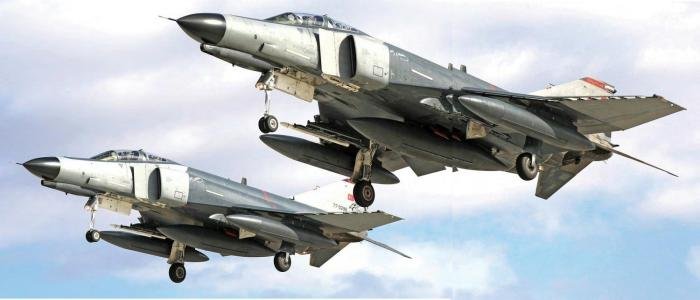
Its F-4Es having initially worn the brown and green South-East Asia camouflage, the THK standardized on ‘European One’ two-tone gray in later years.
Although the moniker ‘Terminator’ was used at the start of the project, this referred to the first squadron that received the aircraft. The upgrade was officially referred to simply as F-4E-2020, in recognition of its aim to keep the jets in front-line service until after 2020.
The first two F-4Es (serials 73-1025 and 73-1032) to undergo the upgrade were sent to Tel Aviv on February 24, 1997.
Modification of the initial example was completed on March 1, 1999, but the aircraft stayed in Israel for another year for testing and verification work. At the same time, 230 technicians slated to work on the 2020 program were trained in Israel. The first two completed F-4E-2020s (serials 73-1032 and 68-0498) were re-delivered to the 111 Filo at Eskişehir in January 2000. As the project ramped up, 171 Filo started to receive upgraded jets and from June 2002, and the program continued at Eskişehir under the auspices of the 1st Air Supply Maintenance Center until completion in July 2003. In fact, the work here was valuable to the THK and offered great experience, which proved advantageous in years to come.
Talk of a further batch of F-4E-2020s fell foul of cost and Israeli activities in Lebanon. Instead, Turkey opted to purchase 30 more F-16s.
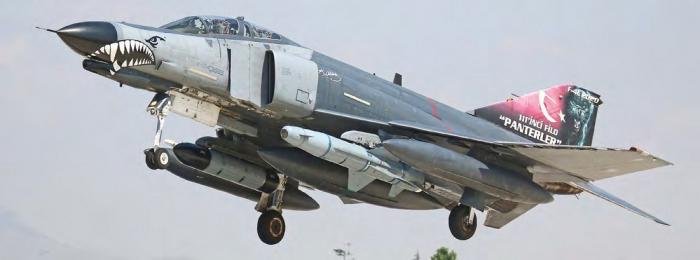
F-4E-2020 serial 77-0285 in special 111 Filo markings and carrying an AGM-142 Popeye standoff missile.
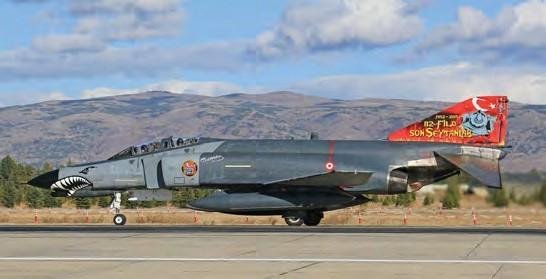
A smart F-4E-2020 of 112 Filo (69-7585) painted for the unit’s disbandment in 2015, and then transferred to 111 Filo.
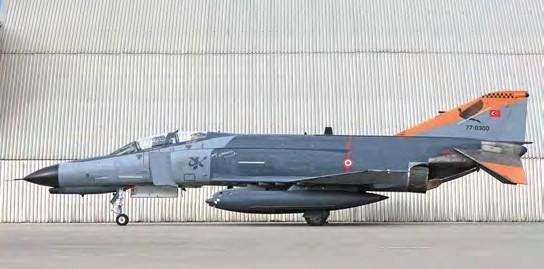
F-4E-2020 77-0300 is one of two attached to the new 401 Development Flight Test Unit under Eskişehir’s 1st Air Supply Maintenance Center Command. The unit is involved in research flight test and development activities.
THE SPECIALS
Indigenous upgrades
A more modest upgrade for 16 older F-4Es was instead completed by Aselsan from 2006, known as the ‘Simsek’ (Lightning) program. This involved 16 jets from 112 Filo, which were then known as F-4E-TM (Turkish Modernization). They received some air-to-ground targeting upgrades and improved navigation and communications kit.
After modernization at Eskişehir, the first upgraded aircraft was delivered to 112 Filo in March 2010.
Project ‘Işık’ (light) preceded this F-4ETM work and was actually the first national aircraft modernization project in Turkey.
It aimed to extend the service life of the RF-4E fleet. Aselsan led the project alongside the 1st Air Supply Maintenance Center, which made good use of its experience with the F-4E-2020 program. Seven RF-4Es from the original batch, plus 11 ex-Luftwaffe jets, received LN-100GT INS/GPS precision navigation, updated electronic warfare and CDU-900 control indicator systems, MFX-484 UHF/VHF radio, ARC-190 HF radio, and new radar warning receiver systems. In addition, five ex-Luftwaffe examples were equipped with the KS-146B LOROP (Long-Range Oblique Photography) pod, which brought the number of aircraft with the ability to carry these pods to 12 and increased the THK’s ability to acquire highresolution imagery from high altitude. The first RF-4E-TM carried out its maiden flight on December 19, 2008. The project was completed by 2010, equipping 113 and 173 Filo and earning the motto ‘Lonely, unarmed and fearless’.
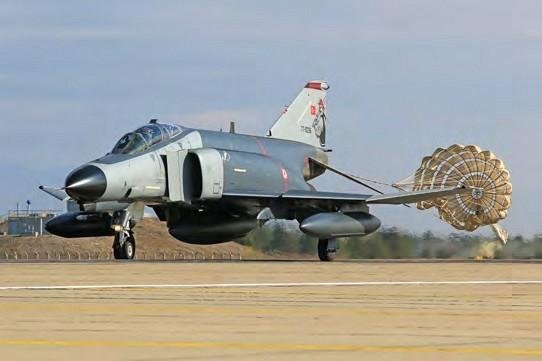
Dragging a billowing ‘chute is one of the former 171 Filo jets now assigned to 111 Filo.
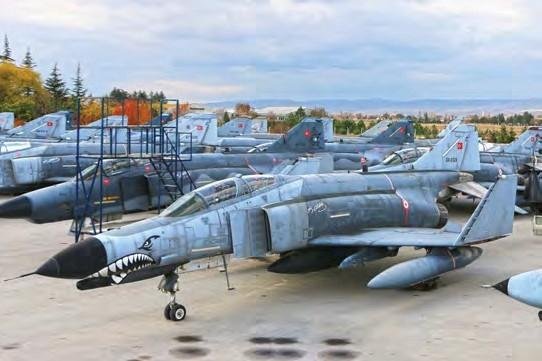
The sad sight of retired F-4E-2020s and RF-4E-TMs. The storage area at the 1st Air Supply and Maintenance Center Command is known as the ‘Tired Fighters Parking Area’.
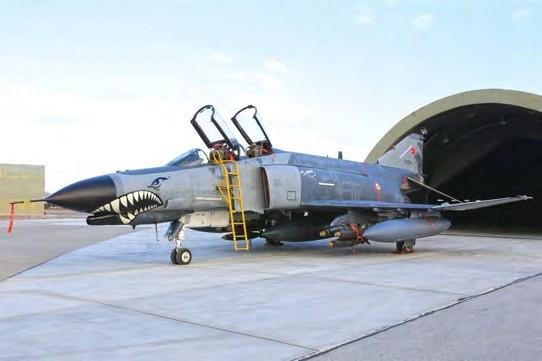
A live-armed F-4E-2020 with Mk82 iron bombs. F-4Es have flight–tested a number of new weapons in recent years including the Stand-Off Munition (SOM) from 2011, Nüfus Edici Bomba (highpenetration bomb), the Precision Guidance Kit known as Hassas Güdüm Kiti (HGK), and the Wing Assistance Guidance Kit known as Kanatlı Güdüm Kiti (KGK).
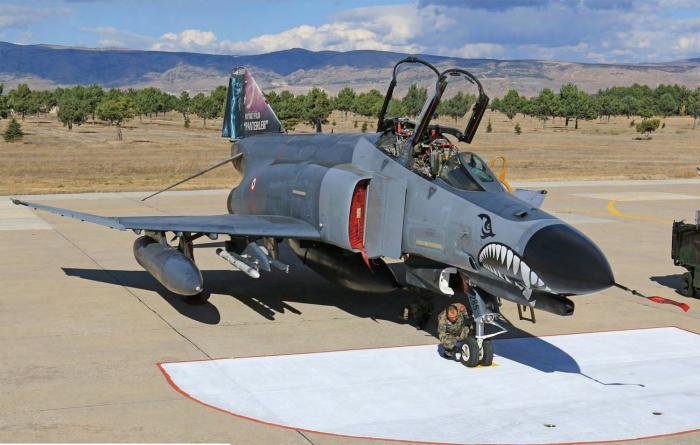
Looking as good as new despite its many years of service, 111 Filo’s flagship 77-0285 on the flightline for its next mission.
Black clouds gather
Having pressed the upgraded RF-4E-TMs into service, poor serviceability plagued these two squadrons. Low aircraft availability led directly to the decision to decommission 113 Filo on April 21, 2014, all remaining aircraft being transferred to 173 Filo.
Even so, misfortune haunted the recce squadron. On June 22, 2012, an RF-4E-TM (77-0314) was shot down by Syrian air defense systems as it flew over the eastern Mediterranean, both pilots being killed. Then, on February 24, 2015, a mid-air collision during a night mission saw the loss of four pilots.
Meanwhile, the Turkish Airborne Reconnaissance Program (TARP) had started integrating the Ultra Electronics DB-110 pod onto the F-16. Plans to retire the RF-4Es were accelerated due to the ill luck that had hit 173 Filo, and the decommissioning process of the eight remaining aircraft was brought forward. On March 12, 2015, the last reconnaissance mission was carried out by serial 77-0315 at Erhaç, bringing an end to the recce Phantom’s service in Turkey.
The situation with the RF-4s was actually being mirrored elsewhere. Age was hitting the THK F-4 inventory fast — even the upgraded F-4E-2020s. The F-4E-TMs were withdrawn, and soon the dwindling fleet of F-4E-2020s was in high demand.
In 2014, 132 Filo ‘Hançer’ stepped out of the F-4 world, donating its ‘2020s’ to 111 Filo ‘Panterler’ at Eskisehir and 171 Filo ‘Korsanlar’ at Erhaç. 112 Filo ‘Seytanlar’ stood down in June 2015, its F-4E-2020s also being sent to ‘Panterler’.
The net result of all the reshuffling and retirements was that, by early 2016, just two THK squadrons continued to fly the F-4 — ‘Panterler’ at Eskişehir and ‘Korsanlar’ at Erhaç.
Things were about to get even worse for the Turkish Phantoms. Straight after an attempted coup d’etat against the Turkish government on July 15, 2016, 171 Filo was shut down as a widespread reorganization hit the THK. 111 Filo ‘Panterler’ was spared and today stands as the only Turkish F-4 unit, flying the remaining F-4E-2020s and still based at Eskişehir.
From a total of 236 Phantom IIs delivered to Turkey, which once served with nine squadrons at three main jet bases, just a handful now linger.
Turkey has become a major operator of the F-16, but it has its sights firmly fixed on the F-35 Lightning II, as well as the indigenous TF-X fighter program.
The last F-4s are acting as an insurance policy against slippage in these new projects. With the THK’s first F-35s due this year, the Phantoms could see service for a few years yet. The official line is still, appropriately, 2020.
A sad-looking dump area for decommissioned Phantoms is now a telling barometer of the situation at 1 Air Supply and Maintenance Center. While the draw-down has been swift but relatively un-noticed in recent years, the F-4E-2020 still has some life left. The aircraft have recently been at the forefront of combat operations over the Syrian border and are continuing to prove their worth, despite their age.
‘PANTERLER’ OPS
Established at Eskişehir in 1954, 111 Filo ‘Panterler’ has been equipped with the F-4E-2020 since January 2000. The unit retains around 40 aircraft today, and it is planned to be re-equipped with F-35 Lightning IIs after 2020.
The squadron maintains an active front-line role, and has been engaged in joint operations over Syria with Russia. It was also involved in suppressing the coup d’etat attempt last year. The squadron’s F-4E-2020s prevented air strikes by taking out the main runway of the 4th Main Jet Base, which was used as the main center of the coup attempt in Ankara.

- List additional actions
LAST OF THE TURKISH PHANTOMS
- Aviation Features
- LAST OF THE TURKISH PHANTOMS
By and photos: Onur Kurc and Tayfun Yasar 2nd March 2017
FEATURE

In its lair at Eskisehir is shark-mouthed 111 Filo ‘Panterler’ F-4E-2020 serial 77-0288, with an Elta EL/L-8222 jamming pod on the shoulder station.
Having undergone a major reshuffle in recent years, the Turkish Air Force has dramatically rationalized its F-4 Phantom II fleet as these warriors ultimately face retirement.
ESKISEHIR IS A city synonymous with the very essence of Turkish aviation. Located in the northwestern part of the country, the airfield has a strong link with the godfather of aeronautics in Turkey: Mustafa Kemal Atatürk. Eskisehir Air Base has housed every fast jet type operated by the Türk Hava Kuvvetleri (Turkish Air Force — THK) and still serves as the home of the 1st Air Base Command, the 1st Air Supply Maintenance Center and, most importantly, the Combat Air Force and Air Missile Defense Command — the glue that cements together all the THK combat elements.
With such a solid legacy, it comes as little surprise that Eskisehir was heavily involved with the arrival of the F-4E Phantom II in Turkish service from 1974. It is dificult to believe that the legendary Phantom II has served for nearly 43 years, and will likely continue in use until around 2020.
Phantom arrival
Turkey has always placed a huge emphasis on its armed forces due to its geographical and geopolitical location. With the country’s entry into NATO in 1952, a new aircraft with more firepower and higher performance was needed to replace the existing F-100C/D/Fs in the THK inventory. The F-4 Phantom II gained public attention during the Vietnam War and was a perfect match for Turkey’s demands at the time.

Therefore, 40 F-4Es were ordered under the ‘Peace Diamond I’ deal with the US. The era of the F-4 also heralded a step-change in air-to-ground capability with the likes of AGM-65A/B Maverick missiles, Pave Spike laser targeting pods, GBU-10/12 Paveway laser-guided bombs, electronic warfare pods and AIM-7 Sparrow medium-range air-to-air missiles. The Phantom was a major leap forward for the THK.

An F-4E flying low over the runway at Erhaç — ‘Korsanlar’ was disbanded during 2016 in the immediate aftermath of the coup attempt, although its demise was probably not linked.

The last-chance check crew gives an Elta EL/L-8222 jamming pod-toting F-4E-2020 a final look over pre-flight.

Phantom tails — 171 Filo ‘Korsanlar’ markings remain in dwindling numbers now the unit has gone. The jet in the middle wears the standard 111 Filo ‘Panterler’ tail markings.

112 Filo ‘Şeytanlar’ stood down in June 2015.

The 5,000th F-4 built, serial 77-0290, still serves with 111 Filo.
The first two aircraft (serials 73-1016 and 73-1017) were flown into Eskişehir by US Air Force pilots on August 30, 1974, and delivered to 113 Filo. Tensions in Cyprus at that time resulted in the biggest combat air operation in the history of Turkish military aviation, the knock-on effect being a significant delay in the operational evolution of the F-4 in Turkey. Deliveries continued in 1975, by which time 22 aircraft equipped 112 Filo ‘Şeytanlar’ (Devils). The remaining 18, which were received after an arms embargo ended during 1977, entered service with 171 Filo ‘Korsanlar’ (Pirates) at Erhaç.
In 1978, the THK ordered a second batch of 40 aircraft, consisting of 32 F-4Es and eight RF-4Es bought under the ‘Peace Diamond II’ agreement. These joined 111 Filo ‘Panterler’ (Panthers) at Eskişehir and 172 Filo ‘Şahin’ (Hawk) at Erhaç. The charismatic RF-84Fs made way for the new RF-4Es, which equipped 113 Filo ‘Işık’ (Light) in 1980.
The story didn’t end there. Turkey was a huge fan of the F-4 and it was proving popular in service. Expansion of the fleet continued, and a further 14 F-4Es were acquired under ‘Peace Diamond III’, these joining 173 Filo ‘Şafak’ (Dawn) also at Erhaç. ‘Peace Diamond IV’ followed; it involved 15 more jets, mainly as attrition replacements, with ‘Peace Diamond V’ adding 40 surplus USAF F-4Es from October 1987. These finally saw off the remaining Super Sabres at Konya, with these Phantoms joining 131 Filo ‘Dragon’ and 132 Filo ‘Hançer’ (Dagger) here. The final batch of deliveries came shortly after the Gulf War ended in 1991, another 40 F-4Es arriving from the US under ‘Peace Diamond VI’.
The end of the Cold War and the military draw-down in northern Europe presented a new opportunity for Turkey. Surplus Luftwaffe RF-4Es were snapped up both by the THK and its neighbor Greece — 46 of these jets (including 13 held in reserve as spares sources) were delivered between 1992 and 1994. Under Project ‘Kaan’, Turkey upgraded these aircraft immediately, replacing the original AN/ APQ-99 radar systems with the newer AN/APQ-172.
These jets boosted 113 Filo at Eskişehir and enabled standardization on a fleet of 20 aircraft per squadron. The remaining examples joined 173 Filo at Erhaç, thus forming a new reconnaissance unit and pushing out the F-4Es to establish 172 Filo alongside them at Erhaç. These ex-Luftwaffe jets initially retained their three-tone ‘Norm 83’ black and green camouflage, but later received a South- East Asia green and brown scheme.
F-4E-2020 AT A GLANCE
In addition to structural work, the 54 F-4E-2020 aircraft were equipped with the Elta EL/M-2032 multi-mode fire control radar with a 144km-range, ELOP 976 wideangle head-up display (HUD), hands-on throttle and stick (HOTAS) controls, new UHF/VHF radio antennas, improved INS/ GPS navigation, new multi-function cockpit displays, flight data recorders, a new radar warning receiver (RWR) and electronic warfare upgrades. Airframe life was extended to 6,000 flight hours.
Another capability for the 2020 was the addition of the AGM-142 Popeye longrange air-to-ground missile. Whilst having the ability to carry a pair of the 3,000lb (1,361kg) weapons, operationally THK Phantoms tend to fly with a single weapon on the port inner station, plus the datalink on the opposite side.
2020 vision
Turkey has continued to invest in its Phantoms, placing a huge emphasis on depth maintenance and upgrade programs. Faced with a decision to replace or modernize the F-4s in the 1990s, it was determined that updating the F-4 was likely to require just a quarter of the cost of replacing the fleet with a new type. Israeli Aerospace Industries (IAI) signed a $632-million contract on August 24, 1995, for the upgrade of 54 F-4Es — 28 were updated by IAI at its Bedek facility, while the remainder were modernized by the 1st Air Supply Maintenance Center at Eskişehir.

Its F-4Es having initially worn the brown and green South-East Asia camouflage, the THK standardized on ‘European One’ two-tone gray in later years.
Although the moniker ‘Terminator’ was used at the start of the project, this referred to the first squadron that received the aircraft. The upgrade was officially referred to simply as F-4E-2020, in recognition of its aim to keep the jets in front-line service until after 2020.
The first two F-4Es (serials 73-1025 and 73-1032) to undergo the upgrade were sent to Tel Aviv on February 24, 1997.
Modification of the initial example was completed on March 1, 1999, but the aircraft stayed in Israel for another year for testing and verification work. At the same time, 230 technicians slated to work on the 2020 program were trained in Israel. The first two completed F-4E-2020s (serials 73-1032 and 68-0498) were re-delivered to the 111 Filo at Eskişehir in January 2000. As the project ramped up, 171 Filo started to receive upgraded jets and from June 2002, and the program continued at Eskişehir under the auspices of the 1st Air Supply Maintenance Center until completion in July 2003. In fact, the work here was valuable to the THK and offered great experience, which proved advantageous in years to come.
Talk of a further batch of F-4E-2020s fell foul of cost and Israeli activities in Lebanon. Instead, Turkey opted to purchase 30 more F-16s.

F-4E-2020 serial 77-0285 in special 111 Filo markings and carrying an AGM-142 Popeye standoff missile.

A smart F-4E-2020 of 112 Filo (69-7585) painted for the unit’s disbandment in 2015, and then transferred to 111 Filo.

F-4E-2020 77-0300 is one of two attached to the new 401 Development Flight Test Unit under Eskişehir’s 1st Air Supply Maintenance Center Command. The unit is involved in research flight test and development activities.
THE SPECIALS
Indigenous upgrades
A more modest upgrade for 16 older F-4Es was instead completed by Aselsan from 2006, known as the ‘Simsek’ (Lightning) program. This involved 16 jets from 112 Filo, which were then known as F-4E-TM (Turkish Modernization). They received some air-to-ground targeting upgrades and improved navigation and communications kit.
After modernization at Eskişehir, the first upgraded aircraft was delivered to 112 Filo in March 2010.
Project ‘Işık’ (light) preceded this F-4ETM work and was actually the first national aircraft modernization project in Turkey.
It aimed to extend the service life of the RF-4E fleet. Aselsan led the project alongside the 1st Air Supply Maintenance Center, which made good use of its experience with the F-4E-2020 program. Seven RF-4Es from the original batch, plus 11 ex-Luftwaffe jets, received LN-100GT INS/GPS precision navigation, updated electronic warfare and CDU-900 control indicator systems, MFX-484 UHF/VHF radio, ARC-190 HF radio, and new radar warning receiver systems. In addition, five ex-Luftwaffe examples were equipped with the KS-146B LOROP (Long-Range Oblique Photography) pod, which brought the number of aircraft with the ability to carry these pods to 12 and increased the THK’s ability to acquire highresolution imagery from high altitude. The first RF-4E-TM carried out its maiden flight on December 19, 2008. The project was completed by 2010, equipping 113 and 173 Filo and earning the motto ‘Lonely, unarmed and fearless’.

Dragging a billowing ‘chute is one of the former 171 Filo jets now assigned to 111 Filo.

The sad sight of retired F-4E-2020s and RF-4E-TMs. The storage area at the 1st Air Supply and Maintenance Center Command is known as the ‘Tired Fighters Parking Area’.

A live-armed F-4E-2020 with Mk82 iron bombs. F-4Es have flight–tested a number of new weapons in recent years including the Stand-Off Munition (SOM) from 2011, Nüfus Edici Bomba (highpenetration bomb), the Precision Guidance Kit known as Hassas Güdüm Kiti (HGK), and the Wing Assistance Guidance Kit known as Kanatlı Güdüm Kiti (KGK).

Looking as good as new despite its many years of service, 111 Filo’s flagship 77-0285 on the flightline for its next mission.
Black clouds gather
Having pressed the upgraded RF-4E-TMs into service, poor serviceability plagued these two squadrons. Low aircraft availability led directly to the decision to decommission 113 Filo on April 21, 2014, all remaining aircraft being transferred to 173 Filo.
Even so, misfortune haunted the recce squadron. On June 22, 2012, an RF-4E-TM (77-0314) was shot down by Syrian air defense systems as it flew over the eastern Mediterranean, both pilots being killed. Then, on February 24, 2015, a mid-air collision during a night mission saw the loss of four pilots.
Meanwhile, the Turkish Airborne Reconnaissance Program (TARP) had started integrating the Ultra Electronics DB-110 pod onto the F-16. Plans to retire the RF-4Es were accelerated due to the ill luck that had hit 173 Filo, and the decommissioning process of the eight remaining aircraft was brought forward. On March 12, 2015, the last reconnaissance mission was carried out by serial 77-0315 at Erhaç, bringing an end to the recce Phantom’s service in Turkey.
The situation with the RF-4s was actually being mirrored elsewhere. Age was hitting the THK F-4 inventory fast — even the upgraded F-4E-2020s. The F-4E-TMs were withdrawn, and soon the dwindling fleet of F-4E-2020s was in high demand.
In 2014, 132 Filo ‘Hançer’ stepped out of the F-4 world, donating its ‘2020s’ to 111 Filo ‘Panterler’ at Eskisehir and 171 Filo ‘Korsanlar’ at Erhaç. 112 Filo ‘Seytanlar’ stood down in June 2015, its F-4E-2020s also being sent to ‘Panterler’.
The net result of all the reshuffling and retirements was that, by early 2016, just two THK squadrons continued to fly the F-4 — ‘Panterler’ at Eskişehir and ‘Korsanlar’ at Erhaç.
Things were about to get even worse for the Turkish Phantoms. Straight after an attempted coup d’etat against the Turkish government on July 15, 2016, 171 Filo was shut down as a widespread reorganization hit the THK. 111 Filo ‘Panterler’ was spared and today stands as the only Turkish F-4 unit, flying the remaining F-4E-2020s and still based at Eskişehir.
From a total of 236 Phantom IIs delivered to Turkey, which once served with nine squadrons at three main jet bases, just a handful now linger.
Turkey has become a major operator of the F-16, but it has its sights firmly fixed on the F-35 Lightning II, as well as the indigenous TF-X fighter program.
The last F-4s are acting as an insurance policy against slippage in these new projects. With the THK’s first F-35s due this year, the Phantoms could see service for a few years yet. The official line is still, appropriately, 2020.
A sad-looking dump area for decommissioned Phantoms is now a telling barometer of the situation at 1 Air Supply and Maintenance Center. While the draw-down has been swift but relatively un-noticed in recent years, the F-4E-2020 still has some life left. The aircraft have recently been at the forefront of combat operations over the Syrian border and are continuing to prove their worth, despite their age.
‘PANTERLER’ OPS
Established at Eskişehir in 1954, 111 Filo ‘Panterler’ has been equipped with the F-4E-2020 since January 2000. The unit retains around 40 aircraft today, and it is planned to be re-equipped with F-35 Lightning IIs after 2020.
The squadron maintains an active front-line role, and has been engaged in joint operations over Syria with Russia. It was also involved in suppressing the coup d’etat attempt last year. The squadron’s F-4E-2020s prevented air strikes by taking out the main runway of the 4th Main Jet Base, which was used as the main center of the coup attempt in Ankara.

Originally published in Combat Aircraft Journal
"Unfortunately, your recent report has been rejected: Post in thread 'TR - TF-X KAAN Fighter Jet' - "monkey model" is a term used for downgraded equipment"
So when America gave us the downgraded version of F-35 apparently mod is just fine them mocking us by saying
"We gave Turks the monkey model." it is technical term he says.
There is no monkey model of F-35. This is simply false. All the F-35s has the same hardware. Only difference is in domestic and export software.
ECM are also should be differentThere is no monkey model of F-35. This is simply false. All the F-35s has the same hardware. Only difference is in domestic and export software.
All systems hav a 'backdoor'. Remember 'Falkland war' and Exocet issue.I have no doubt that any and all weapons we will sell to UAE will be used against us in the future.
Funny stuff. Why would anyone buy western anything including Turkish Airforce's viper closed source code 20 billion order is beyond me as a software engineer that worked on military encryption and communication. Everything western made even in civilian products is filled with backdoors, killswitches and trackers in each and every subsystem even if you are a so called "partner" like we were in F-35.
Even a strong word like stupid seems insufficient. Treasonous seems more appropriate. But then again even I am using Windows.
Even a strong word like stupid seems insufficient. Treasonous seems more appropriate. But then again even I am using Windows.
Don't let pride blind you. If you have no alternative, you manage best of what you can get. That's all it is.Funny stuff. Why would anyone buy western anything including Turkish Airforce's viper closed source code 20 billion order is beyond me as a software engineer that worked on military encryption and communication. Everything western made even in civilian products is filled with backdoors, killswitches and trackers in each and every subsystem even if you are a so called "partner" like we were in F-35.
Even a strong word like stupid seems insufficient. Treasonous seems more appropriate. But then again even I am using Windows.

Canada's Ambassador to Turkey visited TAI. In one of the photographs taken during the visit, the Bombardier Global 6000 jet used for Air SOJ attracts attention. I interpreted the visit as the lifting of Canada's embargo on the project.







